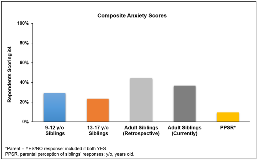Assessing Quality of Life in Siblings of Children With Severe Epileptic Encephalopathies: A Comparative Analysis of Sibling Self-Reports and Parental Perception of Sibling Experiences
Abstract number :
2.423
Submission category :
17. Public Health
Year :
2018
Submission ID :
502077
Source :
www.aesnet.org
Presentation date :
12/2/2018 4:04:48 PM
Published date :
Nov 5, 2018, 18:00 PM
Authors :
Laurie D. Bailey, Zogenix, Inc.; Arnold Gammaitoni, Zogenix, Inc.; Bradley Galer, Zogenix, Inc.; Lauren Schwartz, University of Washington; and Carla Schad, Zogenix, Inc.
Rationale: Recent studies suggest a high economic and humanistic burden on the caregivers of patients affected by a severe pediatric epileptic encephalopathy (EE); however, there is a paucity of information on how these burdens impact the siblings of patients with an EE. The Sibling Voices Survey was conducted to evaluate the psychosocial impact of growing up with a sibling affected by an EE, such as Lennox-Gastaut syndrome (LGS) or Dravet syndrome (DS). Methods: Participants responded to 1 of 4 online, institutional review board-approved, age- and role-specific surveys (parents, siblings 9-12 years old [y/o], siblings 13-17 y/o, and adult siblings =18 y/o) designed in consultation with LGS/DS patient communities and healthcare professionals to address concerns specific to siblings. Scale scores of 0-10, 0-3, or binary yes/no responses were used to assess quality-of-life (QoL) metrics. Four questions assessed potential depressed mood, and two questions assessed potential anxiety symptoms (0-3 scale, low-high). Total scores of =8 (depressed mood) or =4 (anxiety symptoms) were considered indicators of possible mood symptoms. Results: The surveys received 248 submissions (parents, n=128; siblings 9-12 y/o, n=24; siblings 13-17 y/o, n=17; and adult siblings, n=79); sibling respondents represented 107 families of patients with an EE. The median age of the sibling respondents was 21 y/o (range: 9-63 y/o). Substantial differences were observed between siblings’ self-reported responses and parental perception of siblings’ responses in some areas assessing QoL. Composite anxiety scores where siblings’ responses indicated potential anxiety mood symptoms were higher for all sibling cohorts (24%-44%) than parental perception (9%; Figure). Parental perception of unaffected siblings’ unhappiness about their sibling’s epilepsy was lower (25% reported 2 or 3 on a scale of 0-3) than the siblings’ self-reported responses (47%-60% reported 2 or 3 on a scale of 0-3). Sadness was also under-recognized in the parental perception, with 42% of 9-12 y/o reporting scores of 8-10 (of 10) compared with only 14% of parents reporting sadness in this sibling group. There was a =2-fold difference between parental perception and siblings’ responses on items regarding “sadness about the sibling’s diagnosis,” “not getting enough attention from mom and dad,” “how stressed are you over your sibling’s diagnosis,” “how angry are you over your sibling’s diagnosis,” and “how comfortable are you talking with others about your sibling’s diagnosis.” Conclusions: Important difference exist between parental perception and actual sibling self-reports on mood symptoms, such as anxiety, depression, and sadness. These findings highlight the need for increased awareness and ongoing assessment by both parents/caregivers and healthcare providers of the potential need for support for siblings of patients affected by an EE. Funding: The Sibling Voices Survey was supported by a research grant from Zogenix, Inc.
